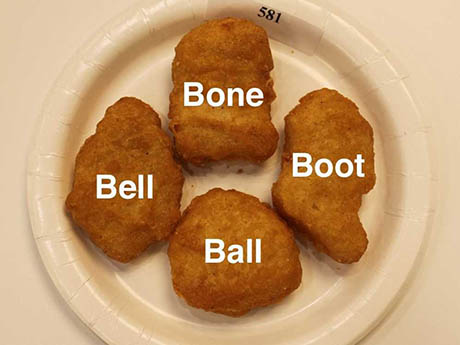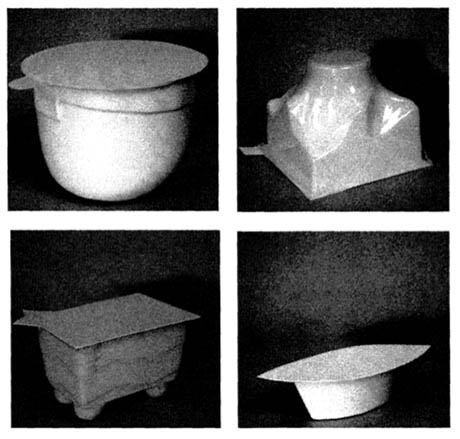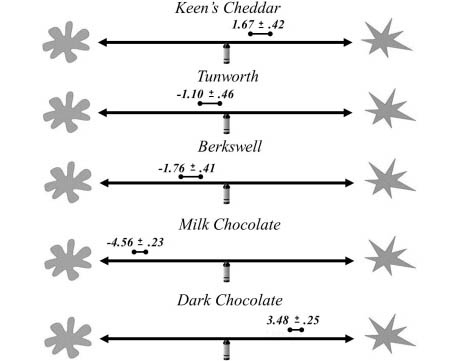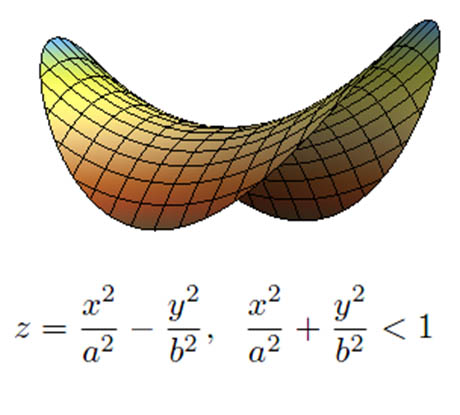
IMAGE: McDonald’s Chicken McNuggets; photograph by Kim Bhasin for Business Insider.
On a sponsored media trip to McDonald’s US headquarters in Oak Brook, Illinois, Barbara J. Booth, the company’s director of sensory science, told Kim Bhasin of Business Insider that Chicken McNuggets come in four carefully designed shapes: the “bell,” the “bone,” the “ball,” and the “boot.”
On the Q&A page of the McDonald’s Canada site, the company confirms that there are indeed four McNugget shapes, although they steer away from the unnervingly meaty connotations of the “bone,” referring to it as a “bow-tie,” instead. This disclosure is made in response to a question from Michael F. from St. John’s, Newfoundland: “How come the boot-shaped are so much more appealing than the oval-shaped ones?”
Although McDonald’s makes a joke of the question, suggesting that people from St. John’s prefer the boot-shaped nugget because it subconsciously reminds them of the shape of the southern region of Newfoundland, it turns out that several recent studies have demonstrated a significant relationship between the shape of a food item and its taste.
For example, in a forthcoming paper in the journal Food Quality and Preference, Charles Spence of the Crossmodal Research Laboratory at Oxford University teams up with colleagues at CSU Long Beach and the School of Advanced Study at the University of London, as well as the legendary British cheese shop, Neal’s Yard Dairy, to investigate the shape symbolism of cheese.

IMAGE: In an extremely small 1991 study, C. J. Overbeeke and M. E. Peters of the Delft University of Technology gathered preliminary evidence to show that people can match the complex 3D shapes of dessert containers to specific pudding flavours and types, and thus, in turn, that designers can express the taste of a dessert in the form of its packaging. Photograph from their paper, “The Taste of Desserts’ Packages,” published in Perceptual and Motor Skills, 1991, 73, 575-583.
Building on both anecdotal evidence from chefs and synaesthetes, as well studies of chocolate selection boxes (milk chocolate is typically matched with round shapes, while dark chocolate is perceived as more angular), beer and its serving glasses, and even three-dimensional dessert pots (with significant implications for the packaging of vanilla pudding and tiramisu), Spence and his co-authors asked their test subjects to rate a range of British cheeses on a soft to spiky scale.
In a series of experiments that reveal the difficult of isolating sensory responses—were participants responding to the “meltingly smooth” mouthfeel of the Tunworth, or its strong and “somewhat ammoniated” flavour?—Spence, Ngo, Percival, and Smith are finally able to conclude that flavour, rather than texture or smell, is the leading contributor to a cheese’s shape association. Keen’s Cheddar, with its sharp, acidic taste, is consistently rated as more angular than the Camembert-style Tunworth or the mellow, nutty Berkswell.

IMAGE: Comparative rankings for Keen’s Cheddar, Berkswell, and Tunworth cheeses, and, as a control, milk and dark chocolate, on Spence, Ngo, Percival, and Smith’s shape symbolism response scale.
Intriguingly, toward the end of the paper, Spence et. al. speculate as to the reverse implications of their findings: the idea that shape—whether of the food item itself or its packaging—sets up a set of flavour expectations even before consumption. They cite as-yet unpublished research that suggests “that any shapes that appear on the packaging may actually influence the perceived taste of the contents,” including a 2007 study that found that, after being asked to evaluate three angular shapes, test subjects rated a piece of cheddar cheese as tasting seven percent sharper than they did after evaluating three rounded shapes.
Given that consumers have been repeatedly shown to enjoy a food substantially more if it matches their sensory perceptions, associating a sharp cheddar with angular shapes has the potential to make it seem significantly tastier. “Even a very subtle effect of shape symbolism on food perception,” Spence, Ngo, Percival, and Smith conclude, “could potentially be very important out in the marketplace.”

IMAGE: The Pringle, the only food item shaped like a hyperbolic paraboloid, was actually designed to solve a packaging problem.
As journalist Michael Moss’s new book, Salt Sugar Fat, details, McDonald’s, along with their junk-food industry colleagues, dedicate an enormous amount of effort to this kind of somatosensory research, studying the tiny nuances of salt crystal size and packaging colour that will, in turn, optimize the consumer appeal of their food.
In other words, it’s a safe bet that McNugget morphology tells us something important about the sensory framework through which we experience the world. Within the constraint of basic economic considerations (shapes that can be made on the same line and ship well), the bell, bow-tie, ball, and boot are sculptures made by our mouths—ubiquitous, finely-tuned artifacts that reflect our increasingly sophisticated understanding of human sensory perception.
2 Comments
Not sure why we should be surprised. Lots of experience with elemental foods teaches us that textures and shapes do represent variances in flavor. The blocky, angular, rough-cleaving nature of a sharp cheddar does have a relationship to its flavor, because that shape results partly from its preparation process. Humans have a lot of knowledge about the linkages between food shapes and flavors; we have the ability to begin to make predictions based on past experience, and it’s no surprise that we apply it to newly invented foods as well. As to the McNugget “boot” – it seems both easier to hold, and offers more of a dip-able shape that’s not likely to coat your fingers in BBQ sauce. The little outward jog practically invites that you start biting there – kind of like the ears on a chocolate bunny.
The angular = sharp vs less angular = mellow makes sense, right? Cheddars are blocky while camembert style cheeses are packaged in rounds. But did this packaging evolve before the science?